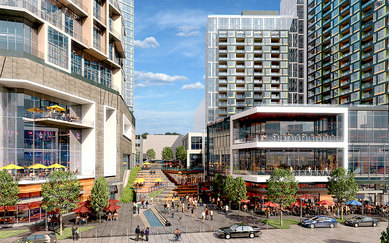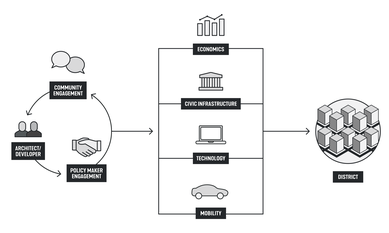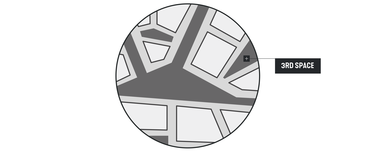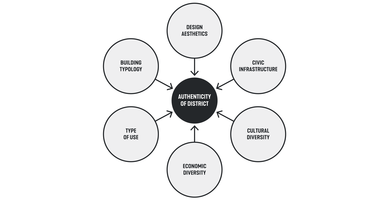Mixed-Use Convergence & The Future of District Developments
There are many drivers in successful district developments and each needs to be considered holistically to ensure the success, vitality, longevity and economic viability of the project. The district, as a unique entity, relates to the individual at both the building scale as well as within the urban context. It provides connections between other districts and communities, can create a unique experience or reality, and has a varied and diverse scale. There are critical components that both enable and inhibit these types of developments, whether they are new or existing.
The excitement surrounding the ideas behind the integration of mixed-use and convergent strategies within a district can be influenced by public policies, an unknown future state, and the incorporation of economic and cultural diversity.

Scotts Run Master Plan
Public Policy
For decades public policy has shaped the built environment. Governmental departments may have the vision to create good policy but must work within the parameters of their process. The integration of the public as part of the entitlements and district development process is a critical component which ensures an engaging and authentic district. Ultimately, the evolution of public policy will catch up with the evolution of society (mobility, technology, etc.). What will this policy evolution look like? How do we empower individual residents, the private sector, and public stakeholders to partner with each other earlier in the process and make real and lasting change within their communities?
Additional components of public policy evolution will include the incorporation of educational and civic infrastructure within the framework of a district. Whether it’s being able to affordably develop mixed income housing, public transportation initiatives, and the use and development of autonomous and ride-sharing infrastructure, public policy will directly affect the viability and success of a district.

Unknown Future State
How do we create a district of the future that considers the present while accommodating and predicting both the known and unknown future state? The creation of dynamic solutions that can adapt to advances in technology, mobility, sustainability, and accessibility will also encourage vibrant growth now, allowing for projects that are agile enough to be ready for the future and the unknowable unknowns that it will bring.
Individual buildings are inherently static but will need to mature and become more dynamic as they interact and enhance the districts of which they are a part. Buildings are, in fact, beginning to evolve in that boundaries are being blurred between uses such as office, entertainment, and living. (Our colleagues Alexis Kim and Bob Varga expand on this topic in a related blog post, Mixed-Use Convergence & the Future of Buildings.) This evolution is beginning to occur at the district level also, with public and private entities working together to enhance the viability of a development. The public realm is no longer a byproduct of the building and elements around it. It is a designed “third space” that is crucial to allowing people to engage and interact within a district.
When developing a district, it is important not to dictate too many prescriptive ideas and give participants and businesses the opportunity to interact and create a distinct district environment. A district could become a series of building-scale modular components that are plug-and-play and allow buildings and external spaces to evolve over time as user needs change and as technology advances. This would, in turn, contribute to creating unique and authentic experiences that evolve organically.

Economic & Cultural Diversity
Opportunities for the community to engage with the culture and diversity of its city are fundamental elements of a district. The importance of this inclusion is more apparent today because people are poised to embrace these elements, recognizing that they make the fabric of cities so wonderful. There are overt and subtle ways that districts can be designed with diversity in mind. Districts that accommodate many uses, building typologies, and design aesthetics create an environment that is welcoming to a larger, more inclusive audience.
Within The District Detroit, SmithGroup was able to create a framework for streets and open spaces, establishing an infrastructure for a range of events and programs. Along with crafting design guidelines for future development, we created a district of new mixed-use neighborhoods all linked together by walkable streets and open spaces. This included creating a deliberate framework for festivals, restful parks, beer gardens, and plazas along with tree shaded streets for cafés, bars, and shops. Our designers and planners were thoughtful about naturally blending ephemeral uses and activities within timeless and enduring spaces. As a result, people have been drawn to these spaces for entertainment, as well as to shop, live, work and perform—all of which enhance the rich culture and diversity of the city.
By influencing how people inhabit this “third space,” architects and developers play a significant role in shaping the look, feel, and authenticity of a district.

Looking Ahead
Convergent design should follow some basic guiding principles at the district scale. First and foremost, there needs to be increased involvement with public policy. We must educate and engage both the policy makers and the public in order to create planning and development requirements that promote diverse, beneficial communities with staying power. In addition, we must plan now for future unknowns. The creation of flexible, adaptable designs that encourage dynamic and vibrant growth both now, and in the future, will allow for longer lasting projects that are agile enough to flex as unknowable unknowns become realities. Finally, a sustainable district must respond and embrace a diverse array of cultural and economic conditions and remain true to its unique setting and environment.